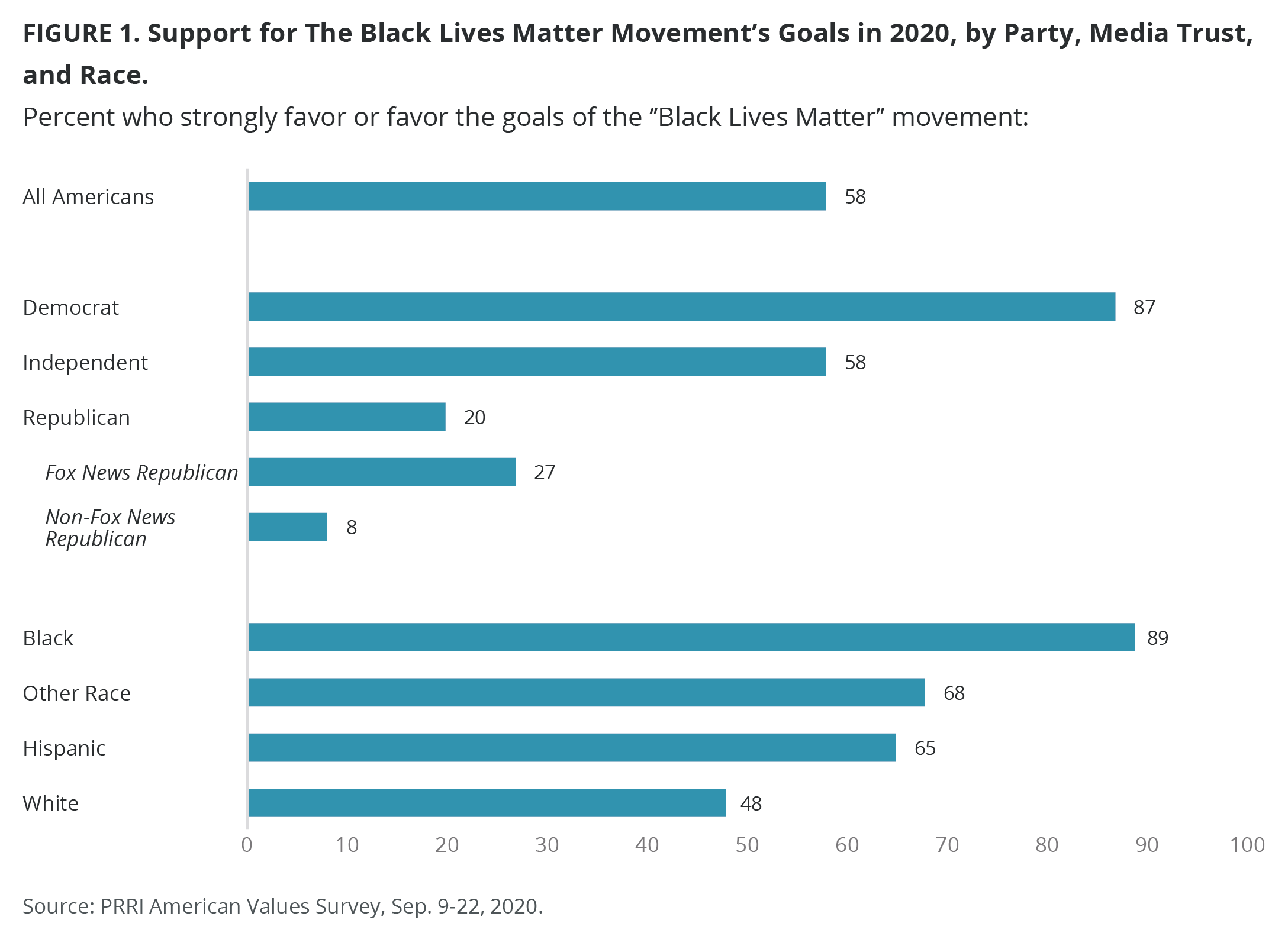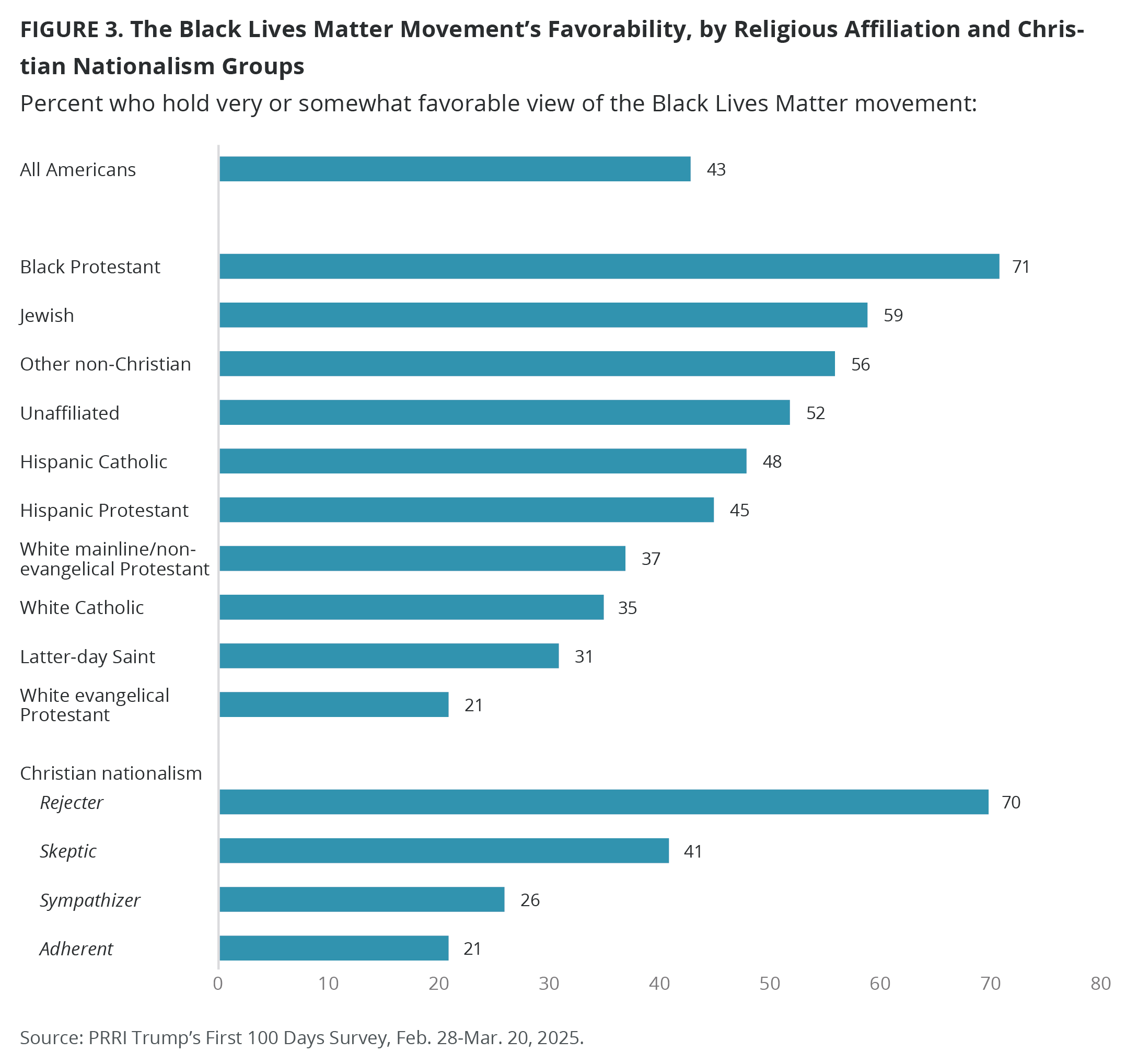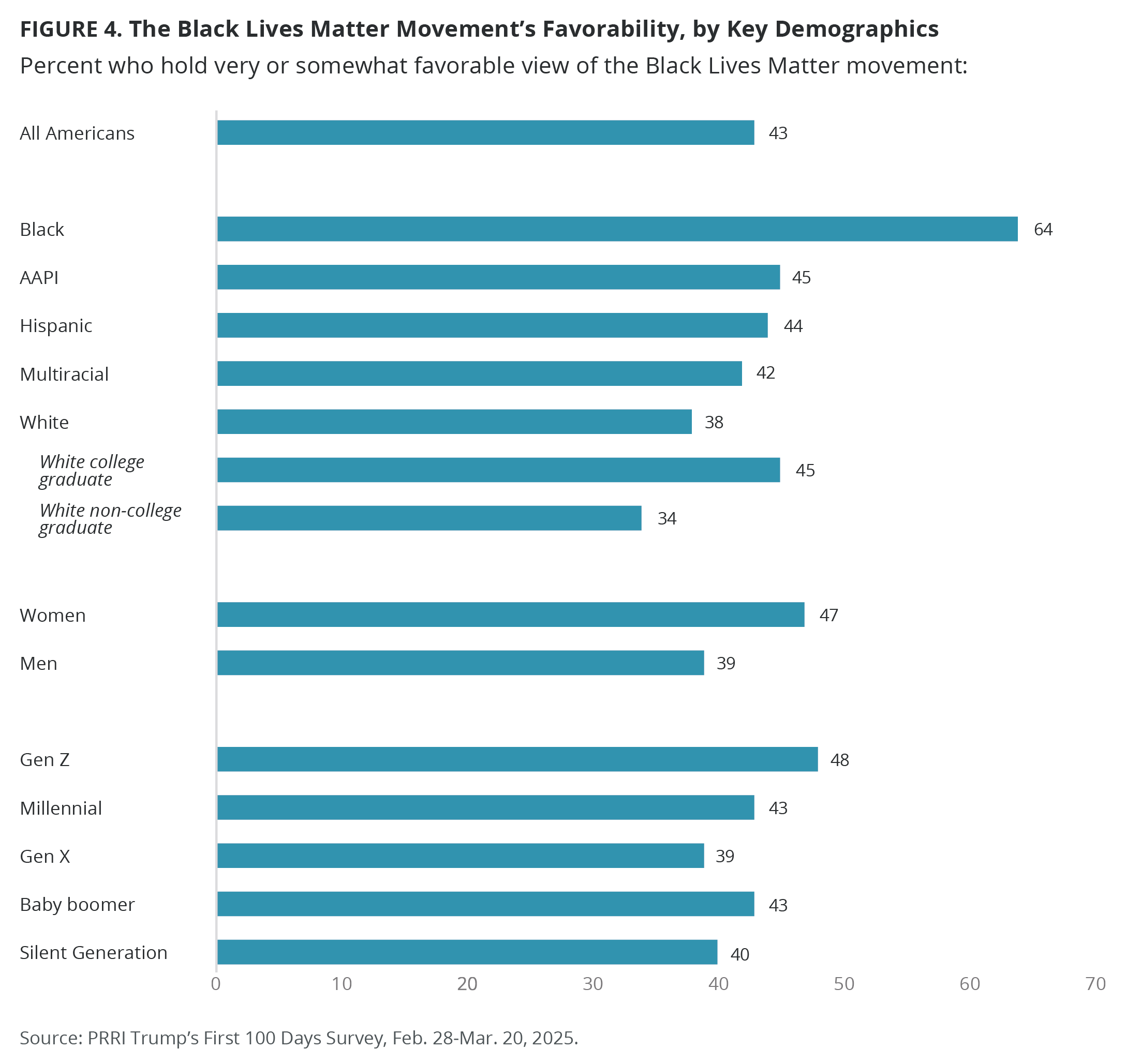Seth Gaiters, Ph.D., is an assistant professor of Religious Studies and Africana Studies at North Carolina State University and a 2024-2025 PRRI Public Fellow.
Witnessing the start of the demolition of D.C.’s Black Lives Matter Plaza on March 10, 2025, Kristy McDowell, a Black area resident, lamented, “I felt it was important to come down here and just see it one last time before it went away.” McDowell described with grief the Trump-enthused and Republican-backed dismantling of the “BLACK LIVES MATTER” street mural that previously graced two blocks of 16th Street NW, just one block north of the White House. This Spotlight Analysis explores the broader significance of this moment for the American public. PRRI data shows that while a majority of Americans supported the goals of the Black Lives Matter movement in 2020, that support has since declined. Today, views are sharply divided along party lines, media consumption, race, religious affiliation, and Christian nationalism groups.
The placement of the “BLACK LIVES MATTER” street mural — a deliberate statement by D.C. Mayor Muriel Bowser — meant it was impossible to miss from the vantage of the White House. Just five years prior, the 48-foot-wide mural had been cemented into permanence. Mayor Bowser had stated, “We sent a strong message that Black Lives Matter, and that power has always been and always will be with well-meaning people. Today, we have transformed the mural into a monument.” Yet, five years later, the mural is no more and is no longer highlighted in the cultural traffic of many Americans’ memories. Elmer Beard, an 87-year-old who was also an observer that day, captured photos and, with a somber air, reflected on the significance of the mural’s removal. “We’ve been through this before,” he shared, his words heavy with the weight of history. For him, this act of contemporary conquest foretold some difficult days ahead for Black people in America: “This is an organized effort from the top of the U.S. government to take us down and back.” His perspective, coming from a survivor of Jim Crow, seems heavily prescient.
PRRI’s 2020 data shows that the majority of Democrats (87%) and independents (58%) favored Black Lives Matter’s goals, compared with only 20% of Republicans. A Republican split was further evident as only 8% of Fox News-trusting Republicans support BLM’s goals, compared with 27% of those who relied on other news sources. PRRI data shows that most Black Americans (89%), other race Americans — including multiracial and AAPI Americans (68%) — and Hispanic Americans (65%) support BLM’s goals, compared with less than half of white Americans (48%). [1]

The Black Lives Matter Plaza is now the Liberty Plaza. Its erasure stems from an old racialized panic that is terrified of Black movement, Black advancement. This administration’s attempt to build public history recognizes that monuments teach us to remember, so they dismembered this one. As literary scholar Elizabeth Alexander eloquently states, “The word remember has a physicality to it—re-member—the idea that without remembrance the corpus of the person or people or place or idea or ideology has been physically torn asunder.” The jarring sound of jackhammers drilling into the street, chipping away at the bright yellow letters, was more than just demolition or road improvement; it was a form of “didactic violence.” This act, in itself, teaches a stark lesson about American history—about what, and more importantly, who is deemed to matter in our still-embattled landscape.
That moment’s demolition marked a disturbing truth in our era: America’s commitment to justice is declining. The steady decline in public support for Black Lives Matter since its 2020 peak reveals a troubling erosion of justice-oriented thinking in America. Ahead of the 100 day mark of Trump’s second administration, PRRI reported a decline, noting that democracy lay at a crossroads in America. Currently, 43% of Americans view the Black Lives Matter Movement favorably, while 49% view it unfavorably, with significant divides by political affiliation (78% of Democrats vs. 14% of Republicans). Favorability also strongly correlates with news consumption, with mainstream TV news consumers showing significantly higher support (59%) compared to Fox News (18%) or far-right news viewers (6%).

In addition, the Black Lives Matter Movement’s favorability varies across religious affiliation. Not surprisingly, favorability is highest among Black Protestants (71%) and other non-Christian/unaffiliated groups, while it is lowest among white evangelical Protestants (21%) and Latter-day Saints (31%), mirroring a clear divide by Christian nationalism groups. Christian nationalism Rejecters (70%) are far more favorable than Skeptics (41%), Sympathizers (26%), and Adherents (21%).

While overall public support has seen a decline, it’s crucial to examine the significant differences within various demographic groups. According to PRRI, Black Americans are the only group with majority favorable views of the Black Lives Matter movement (64%). Pluralities of AAPI (45%), Hispanic (44%), multiracial (42%), and white Americans (38%) also hold favorable views. Notably, 16% of Hispanic Americans have not heard of the movement, which is more than other racial groups. White Americans with a four-year college degree or higher (45%) are more likely to have favorable views than those without (34%). Women (47%) are more likely than men (39%) to view the movement favorably, and favorability is relatively consistent across generations, ranging from 39% (Gen X) to 48% (Gen Z).

As the memory of resistance is chipped away in many, through book bans, anti-DEI and anti-woke campaigns, and anti-Black pedagogies; and while the American monument landscape may in certain places be dismembered of Black Lives Matter, still, Elmer Beard reminds us, “I’ve got faith that if it gets tough enough, we’ll come through.” The GOP-run Congress forced Mayor Bowser to erase the words on a public plaza that were the battle cry of millions protesting anti-Black police brutality in 2020. They can erase the yellow thermoplastic paint once on top of the bonded concrete street, but they can’t erase the message: Black Lives Matter. This year, August 9, 2025, marks eleven years since Michael Brown’s unjust murder by a police officer and the emergence of Black Lives Matter as a powerful movement. I can still hear Black Lives Matter activists chanting and dancing on the street to the rapper Kendrick Lamar’s song that became an anthem for the movement: “We been hurt, been down before… But if God got us, then we gon’ be alright.” It will take Black movement and faith, this is how Black Americans have remembered and testified to the same.
[1] Due to the low number of cases for multiracial, AAPI, and other race Americans, these were collapsed into “Other Race” category.




